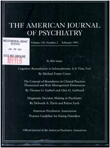The negligible effects of California's 1982 reform of the insanity defense test
Abstract
OBJECTIVE: The authors' goal was to determine whether changing the insanity test in California in 1982 actually affected use of the insanity defense. METHOD: They gathered information on all individuals who entered the insanity plea (N = 1,300) and all those acquitted by reason of insanity (N = 665) in seven counties in California 3 years before and 3 years after the change in the test of insanity. They focused on whether California's revision of the insanity test affected the number and rate of insanity pleas, the number and rate of insanity acquittals, the characteristics of individuals using the defense, the target offenses, and the length of stay of insanity acquittees. RESULTS: The reform did not affect the rate of insanity pleas or acquittals, the characteristics of those using the defense, or their length of confinement. CONCLUSIONS: Although the reform had no direct effects on the use of the insanity defense, the authors hypothesize that an indirect change in criminal sentencing practices led to a decrease in the number and rate of insanity pleas and acquittals.
Access content
To read the fulltext, please use one of the options below to sign in or purchase access.- Personal login
- Institutional Login
- Sign in via OpenAthens
- Register for access
-
Please login/register if you wish to pair your device and check access availability.
Not a subscriber?
PsychiatryOnline subscription options offer access to the DSM-5 library, books, journals, CME, and patient resources. This all-in-one virtual library provides psychiatrists and mental health professionals with key resources for diagnosis, treatment, research, and professional development.
Need more help? PsychiatryOnline Customer Service may be reached by emailing [email protected] or by calling 800-368-5777 (in the U.S.) or 703-907-7322 (outside the U.S.).



